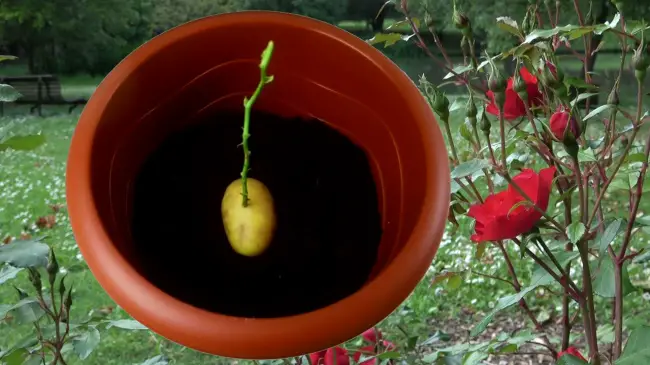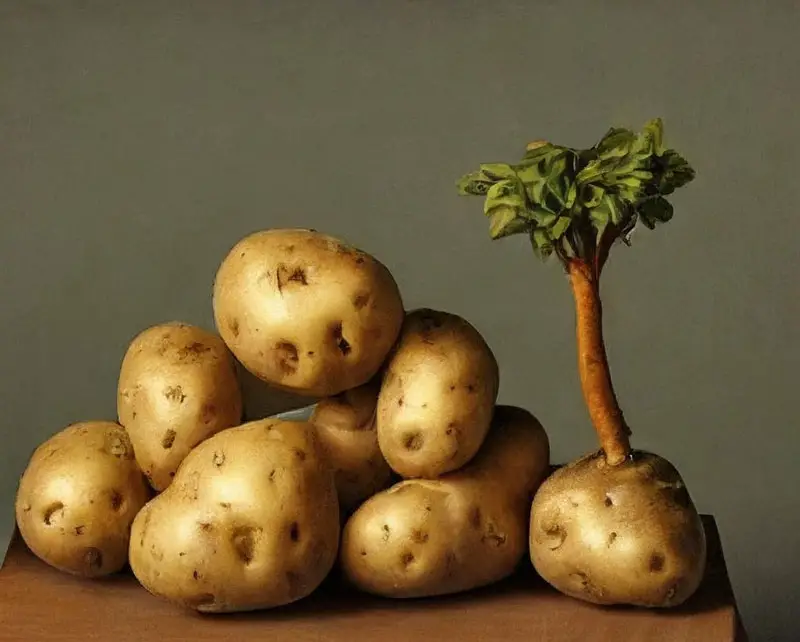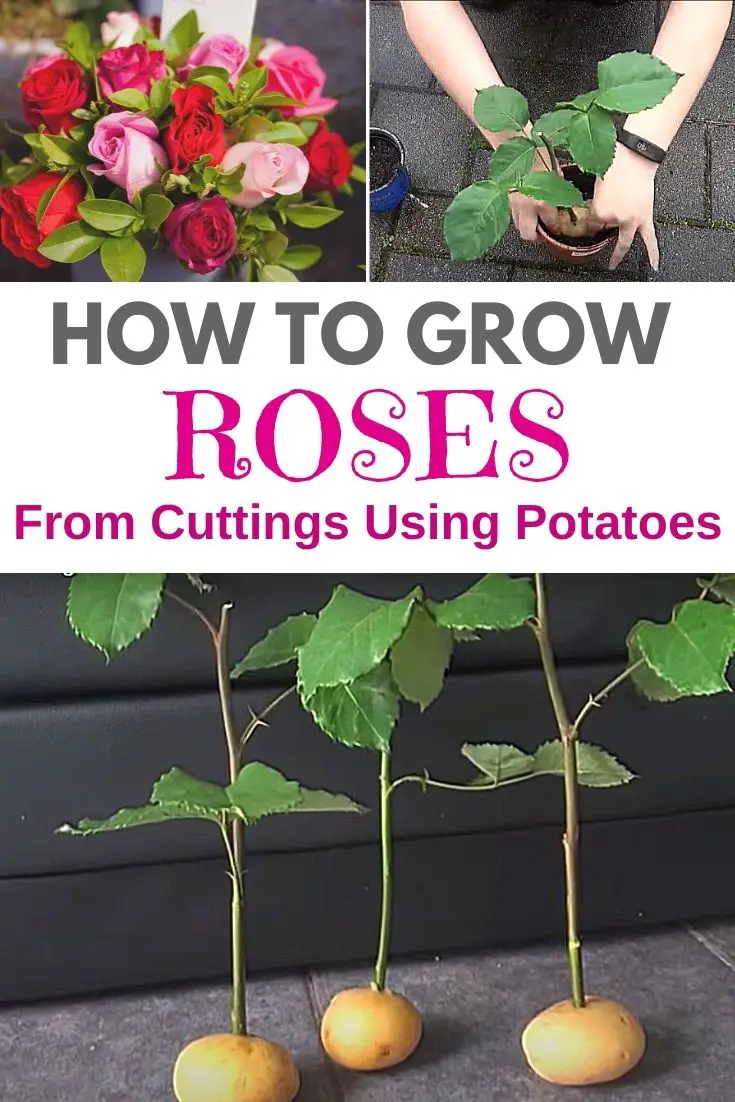Growing roses from cuttings is a fun and rewarding activity. But have you ever heard of using potatoes to do it? Yes, that’s right – potatoes! It might sound strange, but this method has been used for centuries and can be an incredibly effective way of propagating your favorite rose varieties. So if you’re looking for something new and exciting to try in the garden, why not give rose propagation with potatoes a go?
Roses are some of the most amazing plants out there, they grow with thorns, and their flowers have become some of the most loved flowers in the world. Many avid flower lovers will try to grow this plant in their garden or their greenhouse. Some first-time growers may be shocked to hear about using potatoes to help propagate the roses even further.
To grow a rose in a potato, you will need at least 200mm of a stem. With the flower and leaves trimmed off, the stem is then stuck into half of the potato and planted in the ground. This boosts the roots of the stem to start growing and prevents it from going dry, which helps new leaves and roots to grow.
This is not a unique way of propagating plants, with many other plants working as a quick and easy way to promote growth in stems. Having a good base that naturally provides all the nutrients and moisture needed for the new plant to grow means you won’t have to work as hard to ensure the rose will grow. This is often the only way to grow a new rose as the environment might be too tough for new stems to grow naturally.
Here’s everything you need to know about growing roses using one-half of a potato.
How Long Does It Take To Root?
The process of rooting properly through a potato can take anything from five to six weeks if the soil is right. The stem needs to grow new roots from scratch and must be given a chance to grow before you give up on the new rose bush that would be growing fully.
Most people will report that smaller leaves have started to form once the roots are growing effectively. The nutrients provided by the potato and its moisture will mean that the plant won’t go hungry or thirsty. Further, it is easier for roots to grow through the potato in the early stages.
Roses are not the only plants that benefit from the use of potatoes when you plant their stems. Many other larger flowering plants will grow much faster and easier if you provide a good place for their roots to grow. This means that many growers have a steady supply of potatoes ready for growing more of a specific plant.
What Are The Steps You Need To Take?
Please don’t mistake thinking it is as simple as taking a stem and pushing it into a potato then leaving it to grow over time. Several steps have to be completed before the rose stem will grow properly through the propagation technique, even with a potato for extra nutrients. Following these basic steps will mean the difference between having a dried-out twig in a few weeks and growing a plant properly.
Things That You Need:
- Rose stems or branches that are at least 6 inches long (the longer the better).
- Some potatoes with eyes on them.
- A sharp knife or pruning shears.
- A pot filled with soil.
1. Remove flowers
Even when removed from the plant, the flower will be sucking up as many nutrients from the stem as possible. This is why it is possible to give a boost of color to roses by placing them in the right water mixture, which is amazing if you have a whole bushel of roses decorating your house.
However, if you are propagating a rose from just a stem, you do not want the flower to be still attached. The first thing that has to be removed when preparing your stem to be planted, in a potato or just the water, is to remove the flower. This prevents excess moisture and energy from being sucked up and used for anything other than a root system.
2. Remove leaves
The next thing to go is the leaves that are still on the stem. These are removed for the same reason the flower is being removed. But also, because these are too big to do what they need to do, the photosynthesis provided by large leaves is not enough to counter the amount of energy needed to keep them healthy.
Your stem is still busy growing its roots and other leaves, which means it cannot support the mother plant’s larger leaves. If you want your rose to grow properly, it needs to have leaves that are the right scale to its root system, which will be none when planted.
3. Prepare stem
Now that you have the flower and leaves prepared, you need to do just one more thing to the stem before planting it into the potato, cutting it into the right shape. Many people will assume that you cut the stem at an angle, but this will inhibit the roots from forming.
Before you push the rose into the potato, you want to cut the stem into quarters, not too deep, just about one-quarter of an inch right at a stem node. This will divide the stem into four equal parts, which will make it much easier for the stem to start forming its roots in the potato.
4. Plant in Potato
The second to last step is to plant the stem in the potato. However, the potato needs to be prepared as well. You will have to drill a hole slightly smaller than the stem through the potato, making sure the stem is inserted with the skin side of the potato pointing upwards. This will hold the stem properly and allow you to have a rose bush that grows straight up, depending on the kind of rose plant you propagating.
5. Plant in the ground
Before everyday maintenance, the last thing to do will be to plant the potato and stem into the ground. This can be tricky. Sometimes you can plant the potato and stem in the backyard garden. However, this does diminish the chances that the stem will start to grow properly.
It is much safer to plant it in a pot first. Keeping it somewhere, you can easily monitor the stem as it starts to grow. Moving it to larger pots as the root system grows, eventually planting it into the ground where you want your rose bush to grow.
Why Do Roses Grow This Way?
As beautiful as roses and how common they have become in some parts of the world, they are still some of the most difficult plants to grow. There are various reasons for this, and listing them all would make up an entirely new article. The most important part of knowing is that they very rarely have seeds.
This means that most rose trees or bushes are clones of the original where they come from, with growers using stems to grow more as they go along, which has caused many natural ways for rose bushes to become muddled and lost through the ages. Roses grow this way because they need an initial boost in their growth, allowing the stem to suck up everything it needs to grow easily.
Some growers may use sweet potatoes instead of potatoes, but the most accepted version that seems to work most of the time has been potatoes.
Propagating Roses From Cuttings In Other Mediums
Propagating roses from cuttings in other mediums can be a fun and rewarding experience. Instead of using potatoes, there are several other options available that will still yield beautiful blooms.
The first method to consider is rooting rose cuttings in soil. This requires some preparation before planting the cutting, but it’s relatively easy. First, you’ll need to choose an appropriate potting mix for your rose cuttings. Then moisten the potting mix until it’s damp all the way through without becoming soggy or overly wet. Finally, plant your cuttings with their crowns facing down into the soil at least one inch deep and water them thoroughly after planting.
Another option for propagating roses is to use sand as a growing medium instead of soil. Sand has excellent draining properties, making it ideal for rooting rose cuttings. To begin this process, fill a container with coarse-grained horticultural sand and then moisten it until damp all the way through without becoming soggy or overly wet. After that, place your rose cuttings on top of the sand so that their tips are exposed above the surface, and water them thoroughly after planting.
Here are three things to remember when propagating roses:
- Always make sure you have chosen an appropriate potting mix or type of sand for your particular rose variety.
- Make sure you don’t over-water your plants during propagation; too much moisture can prevent adequate root growth.
- Give plants enough light while they’re rooted in either soil or sand; lack of light may result in stunted growth.
No matter which method of propagation you choose, following these simple steps will ensure healthy roots and eventually beautiful blooms!
Benefits of Propagating Roses from Cuttings
The benefits of propagating roses from cuttings are numerous. Not only will it save you money on buying new plants, but it will also give you satisfaction knowing that the plant grew from something you created yourself. Also, since this method takes less time than other propagation methods such as seed germination, it allows for more flexibility when deciding which flowers to grow each season.
Conclusion
Whether you are growing a stem from a bushel of gifted roses or you want your rose bush to continue growing throughout your garden, using potatoes is a surefire way of increasing your chances. After all, there is only a 10% chance that the stem will start growing in normal propagating estimates.
Propagating roses from cuttings using potatoes is a fantastic way to increase your garden’s beauty without breaking the bank. With some patience and practice anyone can become skilled at producing these lovely blooms at home – all I need now is a little bit of luck!
Just be sure the potatoes you are using weren’t meant for tonight’s dinner!




Sounds like a great way to spread soil diseases if you’re using potatoes bought at the market, and not certified, disease free potatoes for planting.